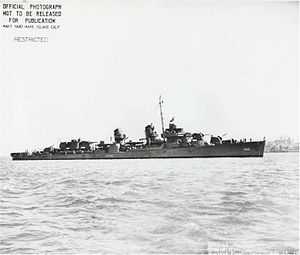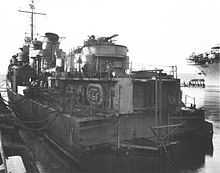USS Abner Read (DD-526)
 USS Abner Read (DD-526) July 1943 | |
| Career (US) | |
|---|---|
| Namesake: | Abner Read |
| Builder: | Bethlehem Shipbuilding Corporation, San Francisco, California |
| Laid down: | 30 October 1941 |
| Launched: | 18 August 1942 |
| Commissioned: | 5 February 1943 |
| Fate: | Sunk by Kamikaze,[1] 1 November 1944 |
| General characteristics | |
| Class and type: | Fletcher-class destroyer |
| Displacement: | 2,050 tons |
| Length: | 376 ft 6 in (114.7 m) |
| Beam: | 39 ft 8 in (12.1 m) |
| Draft: | 17 ft 9 in (5.4 m) |
| Propulsion: | 60,000 shp (45 MW); 2 propellers |
| Speed: | 35 knots (65 km/h) |
| Range: | 6,500 nmi (12,000 km) at 15 kn (28 km/h) |
| Complement: | 336 |
| Armament: | 5 × 5 in (127mm)/38 guns, 10 × 40 mm AA guns, |
USS Abner Read (DD-526) was a Fletcher-class destroyer in the service of the United States Navy, named after Lieutenant Commander Abner Read.
She was laid down on 30 October 1941 at San Francisco by Bethlehem Steel, launched on 18 August 1942, sponsored by Mrs. John W. Gates, and commissioned on 5 February 1943 with Commander T. Burrowes in command.
Service history
The destroyer held shakedown along the California coast into April and then got underway with Task Group (TG) 51.2, bound for the Aleutian Islands. She assumed patrol duties on 4 May and, on the 11th, shelled targets on Attu Island supporting soldiers of the Army's 7th Division who landed and were assaulting that island. The destroyer again bombarded Attu on the 16th before returning to San Diego, which she reached on the last day of May.

After two weeks in drydock at San Francisco, Abner Read got underway on 14 June for Adak, Alaska. Upon her arrival there, she joined Task Force (TF) 16 and, soon thereafter, began patrolling the waters around Kiska Island. On 22 July, as part of TG 16.22, she took part in a heavy bombardment of Kiska. Between 12 and 15 August, the destroyer again shelled Kiska in support of landing operations on that island. On 17 August, American forces discovered that Japan had removed its forces from the island. While she was patrolling off Kiska that night, Abner Read was shaken by an explosion aft at 0150. The exact cause of the blast was unknown, and it was later thought that the destroyer had struck a mine. The concussion tore a huge hole in her stern and ruptured her smoke tanks. Men sleeping in aft compartments suffered from smoke inhalation. In the darkness, a few men fell through holes in the deck into fuel oil tanks below. Soon the stern broke away and sank. Once in the water, the men recovered from the effects of the smoke and could breathe. Abner Read was taken under tow by Ute at 0355 and was pulled to Adak for temporary repairs. The destroyer lost 70 men who were killed or missing, and another 47 were wounded.
Following a month of repair work in various Alaskan ports, Abner Read was towed by Oriole to the Puget Sound Navy Yard, Bremerton, Washington, where she was laid up on keel blocks on 7 October to receive extensive repair work. The yard work was finished on 21 December 1943, and the destroyer commenced training exercises and trials. She moved to Pearl Harbor in February 1944, and while she was underway for Hollandia, New Guinea, her starboard propeller was damaged. This accident required her to put in to Milne Bay, New Guinea, on 1 March for repairs. The ship was then attached to TF 75 and participated in the bombardment of Hollandia on 22 April. She provided fire support for the initial landing at Humboldt Bay by the central attack group in Operation Reckless. Her next targets were on the Wakde Islands off the coast of Dutch New Guinea. She sought to neutralize Japanese airstrips located there by concentrated bombardment, which she conducted on 30 April. Abner Read then moved on to Wewak and, on 12 May, bombarded Japanese batteries which had been hindering the efforts of American motor torpedo boats to destroy enemy barge traffic.
The destroyer rendered fire support for the landings at Arara, New Guinea, and bombarded the Wakde-Toem area on 17 May. As part of TG 77.3, she pounded Japanese targets on Biak in the Schouten Islands. From 8–9 June, she was involved in an engagement with a Japanese task force off the north coast of Biak. Abner Read took part in a night bombardment of Wewak on 18 and 19 June. Her next target was Noemfoor Island, which she hit on 2 July to cover the landing operations on the island. Following this extended period of action, she retired to Seeadler Harbor for tender availability.
Getting underway on 8 August, Abner Read made a trip to Sydney, Australia, before returning to wartime activities in the Pacific. The destroyer supported the seizure on 15 September of Morotai Island in the Halmahera group. Her next action was a shore bombardment on Ponam Island in the Admiralties on 7 October. On 17 October, she then began steaming toward Leyte Gulf, and she entered San Pedro Bay on the 20th, D-day for Leyte, and patrolled off the beachheads in ensuing days.
Fate
In the hope of turning back the American invasion, the Japanese struck back fiercely with sea and air power. On 1 November 1944, the Japanese launched kamikaze attacks on members of TG 77.1, which was patrolling lower Leyte Gulf to protect a beachhead. At approximately 1341, an Aichi D3A "Val" burst into flames and crashed toward Abner Read. A bomb from the raider dropped down one of the destroyer's stacks and exploded in her after engine room. The plane, in the meantime, came down diagonally across the main deck, setting fire to the entire after section. The ship lost water pressure and this made firefighting efforts impossible. At 1352, a tremendous internal explosion occurred, causing her to list about 10 degrees to starboard and to sink by the stern. At 1415, Abner Read rolled over on her starboard side and sank stern first. Destroyers quickly came to the aid of survivors and rescued all but 22 members of Abner Read's crew.
Honors
Abner Read received four battle stars for her World War II service.
DD-769
A second ship, a Gearing class destroyer, DD-769, was assigned the name Abner Read and laid down 21 May 1944 at Bethlehem Steel, San Francisco. Her construction was cancelled on 12 September 1946 and she was scrapped in the ways in January 1947.
References
- ↑ Brown p.129
- Brown, David. Warships Losses of World War Two. Arms and Armour, London, Great Britain, 1990. ISBN 0-85368-802-8.
- This article incorporates text from the public domain Dictionary of American Naval Fighting Ships. The entry can be found here.